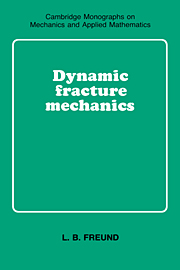Book contents
- Frontmatter
- Contents
- Preface
- List of symbols
- 1 Background and overview
- 2 Basic elastodynamic solutions for a stationary crack
- 3 Further results for a stationary crack
- 4 Asymptotic fields near a moving crack tip
- 5 Energy concepts in dynamic fracture
- 6 Elastic crack growth at constant speed
- 7 Elastic crack growth at nonuniform speed
- 8 Plasticity and rate effects during crack growth
- Bibliography
- Index
7 - Elastic crack growth at nonuniform speed
Published online by Cambridge University Press: 03 October 2009
- Frontmatter
- Contents
- Preface
- List of symbols
- 1 Background and overview
- 2 Basic elastodynamic solutions for a stationary crack
- 3 Further results for a stationary crack
- 4 Asymptotic fields near a moving crack tip
- 5 Energy concepts in dynamic fracture
- 6 Elastic crack growth at constant speed
- 7 Elastic crack growth at nonuniform speed
- 8 Plasticity and rate effects during crack growth
- Bibliography
- Index
Summary
Introduction
The restriction to constant crack speed in the early analytical work on dynamic crack propagation, as reflected in the contents of Chapter 6, was not motivated by physical considerations. Instead, the restriction was imposed in order to render the mathematical models tractable. In this chapter, progress toward relaxing this restriction for rapid crack growth in nominally elastic materials is described. Results are limited, but sufficient to provide a relatively complete conceptual basis for analysis of crack propagation under two-dimensional conditions or in simple structural elements.
The study of a problem involving crack growth at nonuniform rate proceeds in two steps. First, the underlying boundary value problem is considered for arbitrary motion of the crack tip, with a view toward obtaining a full description of the mechanical fields near the crack edge during growth. Then, an additional physical postulate in the form of a crack propagation criterion is imposed on the mechanical fields in order to determine an equation of motion for the crack tip. This approach is illustrated for antiplane shear crack growth, for plane strain crack growth under quite general loading conditions, and for one-dimensional string and beam models. The technologically important issue of crack arrest (Bluhm 1969) is an essential feature in this development; arrest is identified through the crack tip equation of motion as the point beyond which crack growth cannot be sustained.
- Type
- Chapter
- Information
- Dynamic Fracture Mechanics , pp. 367 - 441Publisher: Cambridge University PressPrint publication year: 1990
- 2
- Cited by



